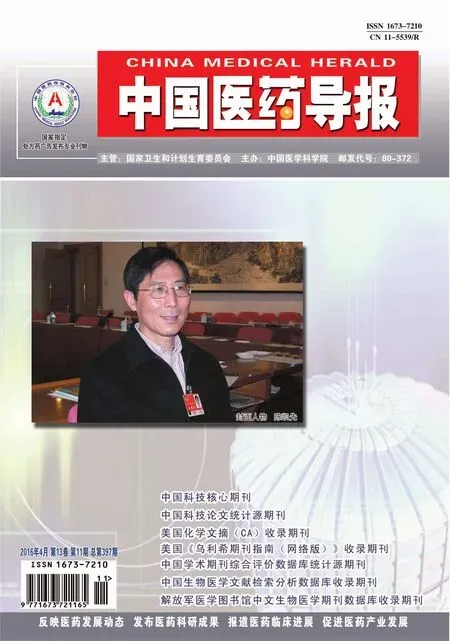急性缺血性脑卒中伴高血糖溶栓治疗的研究进展
2016-02-17王紫阳余积洁湖北省荆门市中医医院老年病科湖北荆门448000湖北省荆门市中医医院医保科湖北荆门448000
王紫阳 余积洁.湖北省荆门市中医医院老年病科,湖北荆门 448000;2.湖北省荆门市中医医院医保科,湖北荆门 448000
急性缺血性脑卒中伴高血糖溶栓治疗的研究进展
王紫阳1余积洁2▲
1.湖北省荆门市中医医院老年病科,湖北荆门448000;2.湖北省荆门市中医医院医保科,湖北荆门448000
缺血性脑卒中是目前导致死亡的第四大病因。静脉注射组织型纤溶酶原激活剂(tPA)可快速恢复缺血组织的血流,是目前治疗急性缺血性脑卒中的有效方案。但30%~40%的脑卒中患者伴高血糖,而急性脑卒中时血糖升高会增加tPA治疗的出血风险,导致临床预后差、死亡率高。目前,高血糖和tPA加重脑卒中后神经血管损伤的机制并不完全清楚,对血糖的控制及tPA的用法仍存在争议。
缺血性脑卒中;高血糖;溶栓治疗
用组织型纤溶酶原激活剂(tissue plasminogen activator,tPA)进行溶栓治疗再通闭塞脑血管是恢复急性缺血性脑卒中患者脑神经元功能的有效方法[1]。在急性缺血性脑卒中时由于缺血再灌注引起的血管损伤等一系列不良事件会导致脑神经元的损伤,但如何降低已存在血管疾病的患者的血管缺血性损伤发生率仍不清楚[2]。据统计,有30%~40%的急性脑卒中患者入院时伴随高血糖,这可能由患者本身患有的糖尿病或应激反应引起的。糖尿病可增加脑血管病和卒中的发病风险,高血糖也与急性缺血性脑卒中的不良预后相关[3]。近年来,越来越多的研究关注于急性缺血性脑卒中时血糖的管理,特别是应用tPA时与高血糖的相互影响[4]。本文综述了急性缺血性脑卒中时高血糖和tPA的相互作用关系、高血糖的管理及tPA的应用、急性缺血性脑卒中伴高血糖的治疗策略等相关研究的最新进展。
1 急性缺血性脑卒中时高血糖和tPA相互作用
研究表明,入院时高血糖或入院后前3 d持续高血糖的急性脑卒中患者与不伴高血糖的急性脑卒中患者比较,功能预后更差[5]。大多数伴有高血糖的急性脑卒中患者有糖尿病史,慢性糖尿病并发症也可能导致神经功能预后差[6]。此外,伴有高血糖的急性脑卒中患者即使无糖尿病史,临床预后依然差[7]。这样矛盾的现象可能是由于一些伴高血糖的急性脑卒中患者有未知的糖尿病史。
在急性脑缺血时,高血糖可能影响溶栓再灌注。例如,高血糖可通过促进凝血酶的生成、激发组织因子途径从而促进血液凝固,也可通过促进纤溶酶原激活物抑制剂(plasminogen activator inhibitor,PAI)的生成从而减弱tPA的纤溶活性。在急性脑缺血时,高血糖可加重或加快一些参与缺血性脑损伤的病理过程,此外,高血糖可增高经静脉tPA治疗的急性脑卒中患者脑出血风险[8]。
2 急性缺血性脑卒中时高血糖的管理及tPA的应用
高血糖是缺血性脑卒中的独立危险因素,有报告指出血糖和功能预后不良之间存在线性关系[9]。创伤性脑损伤时,胰岛素强化治疗会增高低血糖风险且神经功能预后无显著改善[10]。目前急性脑卒中时血糖控制目标指南推荐仍存在不足。AHA/ASA指南推荐急性脑卒中患者住院期间血糖应控制在140~180 mg/dL,ESO缺血性卒中指南建议使用胰岛素使血糖降低到180 mg/dL以下,但两者都未提及tPA治疗期间降低血糖的策略[11-12]。由于用tPA治疗急性脑卒中伴高血糖时可增加脑出血的风险,因此尽快纠正高血糖对治疗脑卒中可能是有益的。静脉注射胰岛素1~2 min后开始起效,故一旦考虑tPA治疗就可给予胰岛素降低血糖以降低脑出血的风险。
虽然,急性脑卒中的溶栓治疗已被许多国家批准,但在欧洲卒中前合并糖尿病是tPA治疗一个排除标准[13]。研究发现,可将tPA治疗的时间窗延长到4.5 h,但不包括脑卒中伴糖尿病或血糖高于400 mg/dL的患者,高血糖是否会缩短tPA治疗的时间窗尚无定论[14]。因此,研究新的治疗方法去降低高血糖时tPA治疗脑卒中的出血风险具有重要的临床意义。
3 基础研究
以下总结了不同高血糖症实验模型对脑卒中近期预后的影响,探讨再灌注损伤和终末结局加重的潜在机制,以及减少脑卒中损伤和促进恢复的治疗策略。
3.1高血糖症模型及其对近期预后的影响
急性高血糖可能由应激反应或糖尿病引起,可增加缺血性脑卒中后神经血管的损伤,导致预后较差[15]。Nedergaard等[16]发现,大脑中动脉闭塞(middle cere bral artery occlusion,MCAO)前的2 d单用链脲佐菌素注射诱导急性糖尿病的大鼠脑梗死面积不变,MCAO前4个月单用链脲佐菌素注射诱导慢性糖尿病的患者梗死面积增加。Ritter等[17]发现脑卒中再灌注后中性粒细胞的黏附和聚集在血管中显著增加,炎症介质黏附分子、白细胞介素-1β在脑内表达增加,这与梗死面积和神经系统的预后不良有关。但是脑卒中预后差不仅仅是由于高血糖脑卒中引起较大范围的梗死。Xing等[18]报道高血糖可增加血脑屏障通透性和出血转化风险,导致预后不良,但对梗死面积无影响。此外研究发现,通过腹腔注射40%葡萄糖溶液使血糖浓度轻度升高(140~200 mg/dL),梗死面积未增加,血管损伤和神经系统预后反而加重[19]。
3.2高血糖再灌注损伤的机制
血液流向缺血组织对修复和挽救缺血半暗带是至关重要的,但再灌注可增加血管损伤,且高血糖可加剧这一过程[20]。高血糖条件下,氧化和应激反应的增强可以改变紧密连接的蛋白结构,从而损害血脑屏障的完整性[21]。高血糖也可加剧内皮细胞线粒体损伤、降低血脑屏障运输,导致血脑屏障完整性丧失,增加出血风险[22]。脑卒中后再灌注治疗的目标是开通闭塞的动脉,恢复脑血流量,下文将着重探讨高血糖再灌注是如何影响脑血管功能,并最终恢复脑血流量。
3.2.1脑卒中时高血糖与脑血流量Kawai等[23]将大鼠MCA闭塞2~4 h后再灌注2 h,并在MCA闭塞前20 min通过腹腔注射葡萄糖诱导急性高血糖。发现与血糖正常组的大鼠比较,高血糖组的大鼠在缺血半球的脑血流量减少。而且,高血糖组的大鼠脑血流量恢复不良与梗死面积增加密切相关。即与血糖正常组比较,高血糖组的脑血流量减少会抑制缺血损伤后的血流代偿,从而加重脑功能障碍。
3.2.2高血糖与大脑的自主调节大脑的自主调节功能是确保灌注压变化时血流量维持恒定的关键[24]。研究表明,大脑平滑肌的肌源性行为在自主调节功能中发挥重要作用,即平滑肌细胞通过收缩或舒张升高或降低血压,从而维持血流量的稳定[25]。Tanne等[26]发现高血糖会使血管舒张,基底张力消失,从而使血管无法应对跨壁压的变化。这与Sieber等[27]的发现相一致,即在非糖尿病狗中,急性高血糖会导致脑血流量的升高和脑血管阻力的降低。以上结果表明,高血糖对血管反应是有害的,可能最终影响脑血流量。
3.2.3高血糖与脑卒中后脑肌源性行为 Palomares等[28]给未受损的大脑中动脉腔内灌注已行MCAO/再灌注2 h后的急性高血糖大鼠的血浆,出现肌张力增加,内皮细胞功能障碍,这表明了急性高血糖伴脑卒中的大鼠血浆中的循环因子在非缺血性脑血管中具有血管活性。近来发现,缺血/再灌注损伤可促使缺血和非缺血半球的大脑中动脉肌张力降低,缺血/再灌注损伤合并急性血糖升高会导致非缺血半球血管肌功能障碍加重,以致中风预后差[29]。以上研究结果表明,急性或慢性血糖升高可能加剧脑肌源性功能障碍,损害有效再灌注,最终导致高血糖脑卒中预后不良。
3.2.4t PA与脑血管功能 FDA批准用重组tPA恢复脑血流治疗缺血性脑卒中,而阻碍tPA在脑卒中患者中应用的最关键因素是脑出血并发症[30]。tPA治疗可引起内皮功能障碍,降低乙酰胆碱和5-羟色胺介导的血管舒张效应,而缺血/再灌注损伤可再加剧上述效应[31]。上述现象表明,tPA治疗对肌源性反应有直接的不利影响,这可能导致脑卒中后血管损伤。钾通道活性是决定膜电位的关键因素,而血管张力受钾通道活性的调节[32]。脑缺氧/缺血会导致钾通道的活性受损,tPA通过上调细胞外信号调节激酶/丝裂原活化蛋白激酶引起自主调节功能受损,加剧脑缺氧/缺血导致的钾通道活性的损害[33]。总之,tPA治疗可能对脑血管反应有不利影响,尤其伴随缺血性损伤时。然而,在高血糖下,tPA对血管功能的影响尚无定论。
4 急性缺血性脑卒中伴高血糖的治疗策略
4.1预防性治疗策略
由于他汀类药物的多效性使其在脑卒中及心肌梗死中有重要的作用。Cakmak等[34]发现在糖尿病组和非糖尿病组小鼠中,脑卒中前用辛伐他汀预处理14 d都可显著减少梗死面积,提升神经系统的预后。噻唑烷二酮类药物是过氧化物酶体增殖物激活受体激动剂,常用于降低血糖。有研究表明,罗格列酮除了降低血糖外,还具有神经保护作用,且长期口服罗格列酮预处理会使神经保护作用更显著、更好,心肌梗死面积减少[35]。
4.2急性亚急性期的治疗策略
目前研究的关键问题是在急性脑缺血时是否可通过迅速纠正高血糖而逆转不利影响,从而改善预后。动物实验发现,局灶性脑缺血时,迅速纠正高血糖引起的脑损伤小于持续性高血糖引起的脑损伤[36]。胰岛素是最常用的血糖调节剂,它在脑缺血前立即应用或脑缺血后几分钟内应用都可减少缺血性脑损伤[37]。这些结果表明,急性脑缺血时高血糖导致的不利影响至少部分可通过迅速纠正高血糖而逆转,这可能与胰岛素具有降血糖以外的神经保护作用有关。除了控制血糖外,在急性缺血性脑卒中患者中,应用铁螯合剂-去铁胺可降低死亡率,减少5-羟色胺、脑水肿及梗死面积[38]。
4.3恢复期的长期治疗策略
缓释型烟酸(Niaspan)是烟酸控释制剂,目前临床用于增加高密度脂蛋白胆固醇和改善血管内皮功能,研究发现其可通过降低血管生成素-2(Ang-2)的表达,促进血管生成素-1(Ang-1)的表达,进而促进了血管重塑,减少出血量和血脑屏障的渗透,改善功能预后[39]。血管再生治疗是脑卒中恢复期的潜在治疗方法。骨髓间充质干细胞对非糖尿病大鼠卒中后功能恢复有促进作用,但会增加死亡率、血脑屏障的通透性和脑出血发生率[40]。
5 展望
高血糖的严重程度对神经元的损伤有重要影响,但轻度升高不增加梗死面积。目前治疗策略的研究重点是减小梗死面积和改善神经功能。但是,很有必要去了解一下这些治疗是如何影响血管功能和脑血流量的。我们应当深入研究tPA与脑卒中伴高血糖治疗之间的相互作用关系。
[1]Darger B,Gonzales N,Banuelos RC,et al.Outcomes of patients requiring blood pressure control before thrombolysis with tPA for acute ischemic stroke[J].West J Emerg Med,2015,16(7):1002-1006.
[2]Zhao H,Bao XJ,Wang RZ,et al.Postacute ischemia vascular endothelial growth factor transfer by transferrin-targeted liposomes attenuates ischemic brain injury after experimental stroke in rats[J].Hum Gene Ther,2011,22(2):207-215.
[3]Yoo DS,Chang J,Kim JT,et al.Various blood glucose parameters that indicate hyperglycemia after intravenous thrombolysis in acute ischemic stroke could predict worse outcome[J].PLoS One,2014,9(4):e94364.
[4]Dong Y,Cao W,Ren J,et al.Vascular risk factors in patients with different subtypes of ischemic stroke may affect their outcome after intravenous tPA[J].PLoS One,2015,10(8):e131487.
[5]Baker L,Juneja R,Bruno A.Management of hyperglycemia in acute ischemic stroke[J].Curr Treat Options Neurol,2011,13(6):616-628.
[6]Tanaka R,Ueno Y,Miyamoto N,et al.Impact of diabetes and prediabetes on the short-term prognosis in patients with acute ischemic stroke[J].J Neurol Sci,2013,332(1-2):45-50.
[7]Masrur S,Cox M,Bhatt DL,et al.Association of acute and chronic hyperglycemia with acute ischemic stroke outcomes post-thrombolysis:findings from get with the guidelines-stroke[J].J Am Heart Assoc,2015,4(10):e2193.
[8]Hafez S,Coucha M,Bruno A,et al.Hyperglycemia,acute ischemic stroke,and thrombolytic therapy[J].Transl Stroke Res,2014,5(4):442-453.
[9]Coester A,Neumann CR,SchmidtMI.Intensive insulin therapy in severe traumatic brain injury:a randomized trial[J]. J Trauma,2010,68(4):904-911.
[10]McCormick M,Hadley D,McLean JR,et al.Randomized,controlled trial of insulin for acute post-stroke hyperglycemia[J].Ann Neurol,2010,67(5):570-578.
[11]Jauch EC,Saver JL,Adams HP,et al.Guidelines for the early management of patients with acute ischemic stroke:a guideline for healthcare professionals from the American Heart Association/American Stroke Association[J]. Stroke,2013,44(3):870-947.
[12]European Stroke Organisation(ESO)Executive Committee,ESO W riting Committee.Guidelines for management of ischaemic stroke and transientischaemic attack 2008[J]. Cerebrovasc Dis,2008,25(5):457-507.
[13]Bruno A,Durkalski VL,Hall CE,et al.The Stroke Hyperglycemia Insulin Network Effort(SHINE)trial protocol:a randomized,blinded,efficacy trial of standard vs. intensive hyperglycemia management in acute stroke[J]. Int J Stroke,2014,9(2):246-251.
[14]Santulli G.Thrombolysis outcomes in acute ischemic stroke patients with prior stroke and diabetes mellitus[J].Neurology,2012,78(11):840.
[15]Ergul A,Li W,Elgebaly MM,et al.Hyperglycemia,diabetes and stroke:focus on the cerebrovas culature[J].Vascul Pharmacol,2009,51(1):44-49.
[16]Nedergaard M,Diemer NH.Focal ischemia of the rat brain,with special reference to the influence of plasma glucose concentration[J].Acta Neuropathol,1987,73(2):131-137.
[17]Ritter L,Davidson L,Henry M,et al.Exaggerated neutrophil-mediated reperfusion injury after ischemic stroke in a rodent model of type 2 diabetes[J].Microcirculation,2011,18(7):552-561.
[18]Xing Y,Jiang X,Yang Y,et al.Hemorrhagic transformation induced by acute hyperglycemia in a rat model of transient focal ischemia[J].Acta Neurochir Suppl,2011,111:49-54.
[19]Elgebaly MM,Ogbi S,Li W,et al.Neurovascular injury inacute hyperglycemia and diabetes:a comparative analysis in experimental stroke[J].Transl Stroke Res,2011,2(3):391-398.
[20]Toufektsian MC,Boucher FR,Tanguy S,et al.Cardiac toxicity of singlet oxygen:implication in reperfusion injury[J].Antioxid Redox Signal,2001,3(1):63-69.
[21]Peterson EC,Wang Z,Britz G.Regulation of cerebral blood flow[J].Int J Vasc Med,2011,2011:823525.
[22]Cipolla MJ,Porter JM,Osol G.High glucose concentrations dilate cerebral arteries and diminish myogenic tone through an endothelial mechanism[J].Stroke,1997,28(2):405-410.
[23]Kawai N,Keep RF,Betz AL.Hyperglycemia and the vascular effects of cerebral ischemia[J].Stroke,1997,28(1):149-154.
[24]Coucha M,Li W,Hafez S,et al.The role of contralateral cerebrovascular myogenic dysfunction in hyperglycemic stroke[J].Stroke,2013,44:A153.
[25]Palomares SM,Cipolla MJ.Vascular protection following cerebral ischemia and reperfusion[J].J Neurol Neurophysiol,2011,2011.
[26]Tanne D,Kasner SE,Demchuk AM,et al.Markers of increased risk of intracerebral hemorrhage after intravenous recombinant tissue plasminogen activator therapy for acute ischemic stroke in clinical practice:the multicenter rt-PA stroke survey[J].Circulation,2002,105(14):1679-1685.
[27]Sieber FE,Brown PR,Wu Y,et al.Cerebral blood flow responsivity to CO2in anesthetized chronically diabetic dogs[J].Am J Physiol,1993,264(4 Pt2):H1069-H1075.
[28]Palomares SM,Morse I,Sweet JG,etal.Peroxynitrite decomposition with FeTMPyP improves plasma-induced vascular dysfunction and infarction during mild but not severe hyperglycemic stroke[J].J Cereb Blood Flow Metab,2012,32(6):1035-1045.
[29]Armstead WM,Riley J,Cines DB,et al.tPA contributes to impairment of ATP and Ca sensitive K channel mediated cerebrovasodilation after hypoxia/ischemia through up-regulation of ERK MAPK[J].Brain Res,2011,1376:88-93.
[30]Albers GW,Bates VE,Clark WM,et al.Intravenous tissue-type plasminogen activator for treatment of acute stroke:the standard treatment with Alteplase to reverse stroke(STARS)study[J].JAMA,2000,283(9):1145-1150.
[31]Cipolla MJ,Lessov N,Clark WM,et al.Post-ischemic attenuation of cerebral artery reactivity is increased in the presence of tissue plasminogen activator[J].Stroke,2000,31(4):940-945.
[32]Faraci FM,Heistad DD.Regulation of the cerebral circulation:role of endothelium and potassium channels[J]. Physiol Rev,1998,78(1):53-97.
[33]Hafez S,Hoda M N,Guo X,et al.Comparative analysis of different methods of ischemia/reperfusion in hyperglycemic stroke outcomes:interaction with tPA[J].Transl Stroke Res,2015,6(3):171-180.
[34]Cakmak A,Yemisci M,Koksoy C,et al.Statin pre-treatment protects brain against focal cerebral ischemia in diabetic mice[J].J Surg Res,2007,138(2):254-258.
[35]Tureyen K,Kapadia R,Bowen KK,et al.Peroxisome proliferator-activated receptor-gamma agonists induce neuroprotection following transient focal ischemia in normotensive,normoglycemic as well as hypertensive and type-2 diabetic rodents[J].J Neurochem,2007,101(1):41-56.
[36]Kim EJ,Kim SY,Lee JH,et al.Effect of isoflurane posttreatment on tPA-exaggerated brain injury in a rat ischemic stroke model[J].Korean J Anesthesiol,2015,68(3):281-286.
[37]Chen CH,Manaenko A,Zhan Y,et al.Hydrogen gas reduced acute hyperglycemia-enhanced hemorrhagic transformation in a focal ischemia rat model[J].Neuroscience,2010,169(1):402-414.
[38]Xing Y,Hua Y,Keep RF,et al.Effects of deferoxamine on brain injury after transient focal cerebral ischemia in rats with hyperglycemia[J].Brain Res,2009,1291:113-121.
[39]Yan T,Chopp M,Ye X,et al.Niaspan increases axonal remodeling after stroke in type 1 diabetes rats[J].Neurobiol Dis,2012,46(1):157-164.
[40]Chen J,Ye X,Yan T,et al.Adverse effects of bone marrow stromal cell treatment of stroke in diabetic rats[J]. Stroke,2011,42(12):3551-3558.
Research progress of throm bolytic therapy in acute ischem ic stroke w ith hyperglycem ia
WANG Ziyang1YU Jijie2▲
1.Department of Geriatrics,Hospital of Traditional Chinese Medicine of Jingmen City,Hubei Province,Jingmen 448000,China;2.Medical Insurance Section,Hospital of Traditional Chinese Medicine of Jingmen City,Hubei Province,Jingmen448000,China
Ischemic stroke is considered the fourth leading cause of death.Tissue plasminogen activator(tPA),which can be used to restore blood flow to the ischemic tissue through intravenous injection,has proven to be effective therapy for treating acute ischemic stroke.But 30%-40%of stroke patients present with hyperglycemia,elevated blood glucose in acute stroke can increase the risk of bleeding with tPA treatment and it is associated with poor prognosis and high mortality rates.Currently,the mechanism through which hyperglycaemia and tPA worsen the neurovascular injury after stroke are far from clear,and the control of blood glucose and tPA treatment are still controversial.
Ischemic stroke;Hyperglycemia;Thrombolytic therapy
R743
A
1673-7210(2016)04(b)-0035-04
湖北省自然科学基金面上项目(2015CF830)。▲
(2016-01-10本文编辑:任念)
